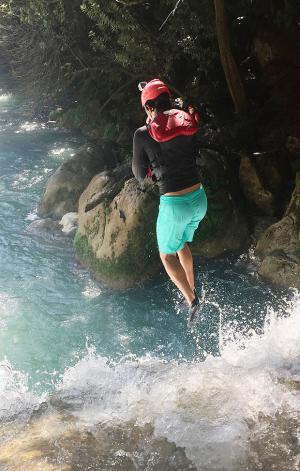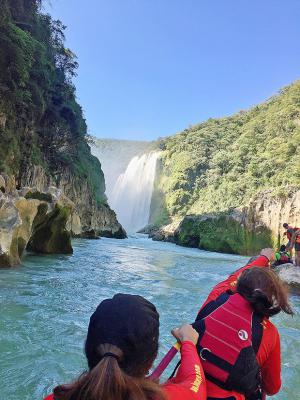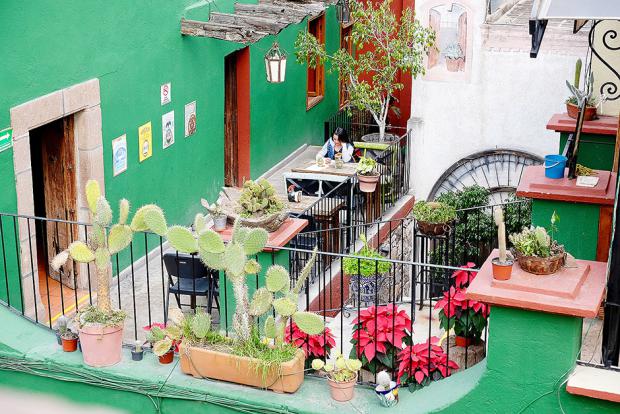Suzanne Morphet, collaborator of National Post, published an interesting article titled “Mexico’s adventure hot spot: Take the plunge in Huasteca, then enjoy delights of San Luis Potosi”. So check it out…
“Don’t think about it, just jump,” says our guide, advising us about our next adventure – jumping waterfalls.
Wearing life-jackets and helmets, we warily follow him and several other guides down a path to Mexico’s Micos River. Cool water rushes around our calves as we step into the river and walk out onto a ledge above a two-metre waterfall.
The river is gorgeous; a wide turquoise ribbon edged with a thick canopy of trees. But the waterfall looks like it could be dangerous. I cautiously peer over the edge, take a big breath and leap, trusting that the water below is deep and forgiving.

A man leaps from the top of a waterfall on the Micos River, where visitors can jump and float from one to the next. While the highest is a nerve-racking eight metres, done right it’s considered safe. (Photo: news.nationalpost.com / Suzanne Morphet)
It is. I surface quickly, my face breaking into a grin as I give the signal that all is well.
Until this trip, my idea of Mexico was sunbathing on sandy beaches, snorkelling in warm water and sipping margaritas while watching the sun sink over the Pacific Ocean.
Then I heard about the city and state of San Luis Potosi, almost smack in the middle of Mexico, and the region of Huasteca (pronounced Wa-STAKE-a). Here in Huasteca water springs from the ground, giving birth to numerous rivers. They tumble over rocky ledges or plunge off sheer mountain sides. Water has also carved caves out of the sedimentary rock, some so big that birds nest in them by the thousands.
The part of Huasteca that’s in the state of San Luis Potosi has become an adventure hot spot with rafting, rappelling, canoeing, standup paddle boarding and jumping waterfalls.
After our first waterfall, we jump six more, swimming or floating lazily with the current from one to the next. The highest is a nerveracking eight metres. It sounded like a crazy idea, but done right it is safe. “Absolutely,” one man in the tourism industry here told me, adding than an 89-year-old man had been jumping waterfalls just before we arrived.
Another day we have a choice of adventure – rafting or canoeing the Tampaon River. I may be bold enough to jump waterfalls, but when I learn that the 15-km section of the river used by rafters is a ‘class three’whitewater, I opt for paddling a flatter section of the river by canoe.
A dozen or more brightly painted, traditional canoes called pangas line the shore, some big enough to hold 20 or more people.
We paddle upstream for about an hour, passing a rocky shoreline that’s been sculpted by water over millennia. The current is strong enough in one area that we go ashore and wait while our guides line the canoe through the rapids.
Back in the panga, we soon hear the thunder of falling water. Rounding a bend, we see Tamul waterfalls, the biggest in the state and almost twice as high as Niagara Falls at 105 metres. The sun is at the perfect angle, lighting up the water as it plunges over the edge.

Paddlers approach spectacular Tamul waterfalls on the Tampaon River. At 105 metres, it’s the highest waterfall in the state of San Luis Potosi. (Photo: news.nationalpost.com / Suzanne Morphet)
Huasteca offers other kinds of adventures besides wet ones. One morning we drive a winding road to the town of Xilitla to visit an unusual garden. Along the way, bright red poinsettias beckon from roadside stands. We stop at one stand to try some locally grown coffee and homemade cinnamon buns.
Arriving in Xilitla, we learn about Edward James, a blue-blooded British art collector and patron of Salvador Dali.
“He travelled around Mexico for two years looking for a place,” our guide tells us, explaining that James had a vision to create a surrealistic garden.
When he arrived here in 1949 and saw orchids growing wild, he fell in love with the place. Blue Morpho butterflies confirmed this was the spot.
We pause near the garden’s entrance to appreciate an eclectic assortment of concrete structures set amid the luxuriant vegetation: a pair of hands, some Gothic arches, and what looks like a giant wedding ring. Then we explore this verdant garden, climbing spiral staircases with no handrails, crossing narrow bridges with sharp drop-offs, and squeezing through slot-like doorways.
By the time we reach natural waterfalls at the top of the 11-acre property, we understand why locals called James, who died in 1984, “a crazy Gringo” but there’s no denying his garden is enchanting. On the way back to our hotel we stop to hike up to Swallow’s Cave, a dramatically deep abyss in a limestone mountaintop. Peering over the edge, the sheer walls end in a dark pit far below. More than 500 metres, this shaft could contain Toronto’s CN Tower with a bend or two.
But the most amazing thing is the bird life. Every few minutes we hear the rush of wings as hundreds of swifts (not swallows, despite the cave’s name), as well as parrots and parakeets do a death-defying downward spiral to their nests in the clefts of the walls, where they spend each night. We walk back to our van as darkness descends, birds still winging overhead.
After three days of adventures, we reluctantly leave Huasteca and drive four hours to the city of San Luis Potosi. It’s the state capital and an industrial centre. Gold and silver gave the city clout in 1592 after its founding. Now it thrives on manufacturing, especially auto parts.

A rooftop restaurant in the city of San Luis Potosi. The walkable, historic city is home to magnificent churches and abundant green spaces. (Photo: news.nationalpost.com / Suzanne Morphet)
Suzanne MorphetA rooftop restaurant in the city of San Luis Potosi. The walkable, historic city is home to magnificent churches and abundant green spaces.
But it’s the historic city centre, now a UNESCO World Heritage Site that makes San Luis Potosi a contender for tourists. Easily walkable, the old city reminds me a bit of Rome, with magnificent churches everywhere.
The church dedicated to Our Lady of Carmel is widely considered to be the most beautiful of all, with a pink limestone façade and a baroque interior with gold-gilded altars.
Local tour guide and history buff Lorelei Jones tells me it’s “the only church in the city that still has baroque elements since most of the churches were remodelled in neoclassical style in the 1800s.”
Along with churches, San Luis Potosi boasts abundant green spaces, whether it’s a square with fountains and benches, or a garden from the days of the Jesuits and Franciscans, when religious orders grew their own fruits and vegetables.
A theatre and several interesting museums round out the old city’s cultural offerings, including the National Mask Museum and the Regional Museum, the latter housed in what was once the country’s largest Franciscan monastery.
Beautiful beaches and big resorts have their place, but when you’re ready to get off the beaten path in Mexico and enjoy “adventure by day, comfort by night,” as one of my friends puts it, San Luis Potosi is the place.
Source: http://news.nationalpost.com/

